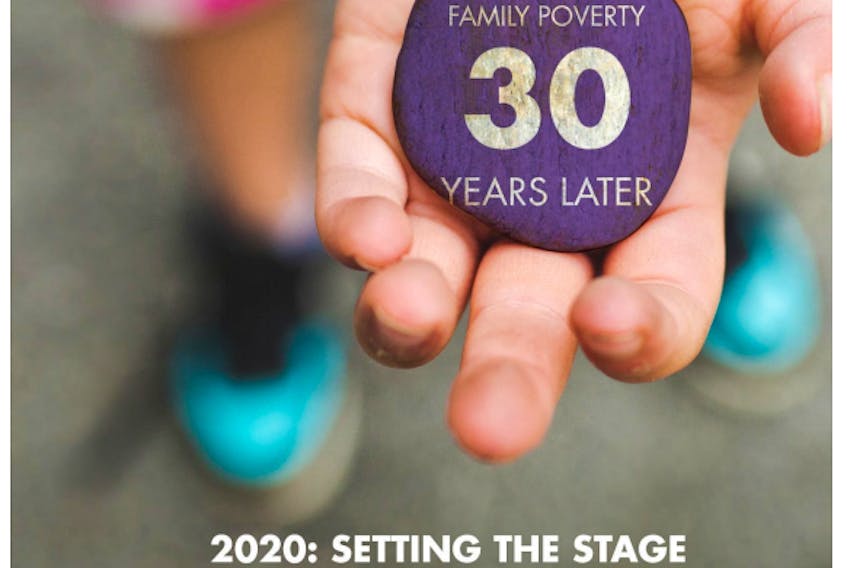No matter how you cut it, efforts by Nova Scotia governments to fight child and family poverty – from 1989 to today – have been abject failures.
This week Campaign 2000, a non-partisan network of organizations focused on ending childhood and family poverty, released its annual report card, entitled Child and Family Poverty 30 Years Later. The title refers to the 1989 resolution – passed unanimously in Parliament – to eradicate child poverty by the year 2000.
Since 1989, child poverty has decreased by just 3.3 percentage points nationally, an average decline of .12 points per year. At that rate, it would take almost 156 years to eliminate child and family poverty.
No province fared worse than Nova Scotia. In 1989, almost one in four kids in Nova Scotia was growing up in poverty, and in 2017 – the last year for which there’s data – one in four kids was still impoverished. Indeed, over those 28 years Nova Scotia managed to reduce its child/family poverty rate by just 0.8 per cent.
The poverty rate among children and families in Nova Scotia stands at 24.2 per cent, about 30 per cent higher than the national rate. New Brunswick’s rate is 21.7 per cent; Newfoundland and Labrador sits at 20.2 per cent; and Prince Edward Island matches the national figure of 18.6 per cent.
Racism and gender discrimination are reflected in the shameful statistics. In Nova Scotia more than a third of visible minority kids are poor as are almost half of single-parent families where the parent is the mom.
Those characteristics are common – to varying degrees – across the country, but Nova Scotia’s higher rates and abysmal record reducing poverty are attributed to a failure of government. Nova Scotia is the only province where the three-year-old federal Canada Child Benefit didn’t cut into the child and family poverty rates.
Low wages are clearly part of the problem. In those provinces with the lowest minimum wages, child poverty is highest.
Nova Scotia’s five-year transition of income assistance – completed this month – leaves most families and kids worse off than when it started, and the tax measures the government claimed would have a positive impact on poverty are more cosmetic than real.
“Nova Scotia has performed very poorly in reducing child poverty despite the introduction of the Canada Child Benefit in 2016. These reports remind us of how many children we are leaving behind, how broken our social contract is, and the urgency to fix it,” said Lesley Frank, associate professor of sociology at Acadia University.
A companion to the national report, focused exclusively on Nova Scotia, notes that while the province’s child poverty rates have been above the national average consistently over the past 30 years, the gap has widened since 2014.
“While the Nova Scotia government challenges the validity of the numbers, families continue to struggle … to meet their daily needs,” says the Nova Scotia report card.
On the validity of the data, Nova Scotia’s Liberal government can choose its poison. Nova Scotia has the worst child poverty rate among all provinces when Canada’s official measure of poverty, the Market Basket Measure, is applied. It falls into a virtual tie for second-worst using the more comprehensive Low Income Measure, after taxes (LIM-AT) preferred by Campaign 2000.
The report says Canada – the 10th wealthiest nation on Earth but with a higher child poverty rate than 20 other OECD nations – has a moral responsibility to protect children from harm and defend their human right to grow up free from deprivation.
If you need more tangible reasons to insist governments attack child poverty, consider that poor kids are more likely to face a lifetime of poor physical and mental health, generally achieve lower academic results and work-life success and are more likely to engage in risky behaviour and run into trouble with the law.
“Enlightened self-interest should lead us to favour more effort to reduce child poverty,” the report states, because the costs of managing its negative outcomes are greater than redressing the injustice in the first place.
While the national poverty reduction strategy announced in 2018 is seen as a step in the right direction, it is not nearly enough.
Among the remedies advocated by Campaign 2000 are dramatic increases in income assistance, a $15-per-hour minimum wage, an increased investment in affordable housing and a comprehensive, universal national pharmacare program.
The Nova Scotia report notes that the provincial government likes to boast about its streak of balanced budgets, but “underspending while thousands of children live in poverty is nothing to boast about.”
That sounds right.
Jim Vibert, a journalist and writer for longer than he cares to admit, consulted or worked for five Nova Scotia governments. He now keeps a close and critical eye on those in power.









